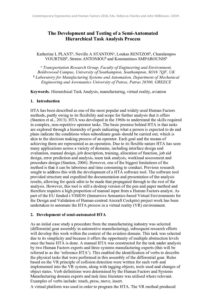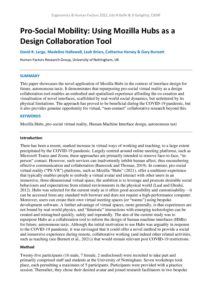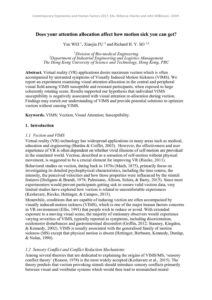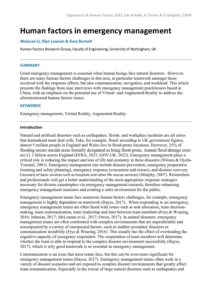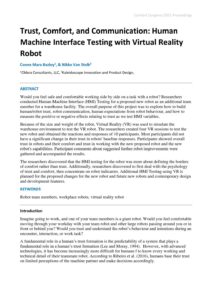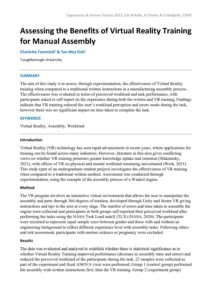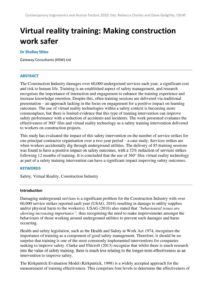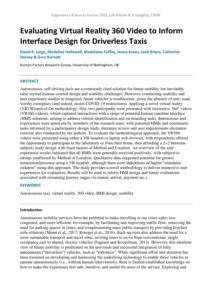Virtual reality
The Development and Testing of a Semi-Automated Hierarchical Task Analysis Process
| Document | Author Katherine L PLANT, Neville A STANTON, Loukas RENTZOS, Charalampos VOURTSIS, Stratos ANTONIOU and Konstantinos SMPAROUNIS |
| Abstract |
Pro-Social Mobility: Using Mozilla Hubs as a Design Collaboration Tool
| Document | Author David R. Large, Madeline Hallewell, Leah Briars, Catherine Harvey & Gary Burnett |
| Abstract This paper showcases the novel application of Mozilla Hubs in the context of interface design for future, autonomous taxis. It demonstrates that repurposing pro-social virtual reality as a design collaboration tool enables an embodied and spatialised experience affording the co-creation and visualisation of novel interfaces, scaffolded by real-world social dynamics, but unfettered by its physical limitations. The approach has proved to be beneficial during the COVID-19 pandemic, but it also provides genuine opportunity for virtual, “non-contact” collaborative research beyond this. |
Does your attention allocation affect how motion sick you can get?
| Document | Author Yue WEI, Xiaojin FU and Richard H. Y. SO |
| Abstract Virtual reality (VR) applications desire maximum vection which is often accompanied by unwanted symptoms of Visually Induced Motion Sickness (VIMS). We report an experiment examining visual attention allocation in the central and peripheral visual field among VIMS susceptible and resistant participants, when exposed to large coherently rotating scene. Results supported our hypothesis that individual VIMS susceptibility is negatively associated with visual attention re-allocation during vection. Findings may enrich our understanding of VIMS and provide potential solutions to optimize vection without causing VIMS. |
Human factors in emergency management
| Document | Author Weixuan Li, Glyn Lawson & Gary Burnett |
| Abstract Good emergency management is essential when human beings face natural disasters. However, there are many human factors challenges in this area, in particular teamwork amongst those involved with the response efforts, but also communication, navigation, and workload. This article presents the findings from nine interviews with emergency management practitioners based in China, with an emphasis on the potential use of Virtual- and Augmented-Reality to address the aforementioned human factors issues. |
Lessons in the Metaverse: Teaching University students about Virtual Reality from within Virtual Reality
| Document | Author Gary Burnett & Catherine Harvey |
| Abstract There is considerable potential in the education sector for the use of immersive virtual worlds to enhance student learning and engagement. This paper outlines five key recommendations for teaching University students in future ‘Metaverse’ contexts. These guidelines are based on video/survey data collected from 266 students during a module that has run predominately in virtual reality for the last three years, as well as the reflective experiences of the teachers. |
Trust, Comfort, and Communication: Human Machine Interface Testing with Virtual Reality Robot
Assessing the Benefits of Virtual Reality Training for Manual Assembly
| Document | Author Charlotte Temmink & Yee Mey Goh |
| Abstract The aim of this study is to assess, through experimentation, the effectiveness of Virtual Reality training when compared to a traditional written instructions in a manufacturing assembly process. The effectiveness was evaluated in terms of perceived workload and task performance, with participants asked to self-report on the experience during both the written and VR training. Findings indicate that VR training reduced the user’s workload perception and errors made during the task, however there was no significant impact on time taken to complete the task. |
Virtual reality training: Making construction work safer
| Document | Author Dr Shelley Stiles |
| Abstract The Construction Industry damages over 60,000 underground services each year, a significant cost and risk to human life. Training is an established aspect of safety management, and research recognises the importance of interaction and engagement to enhance the training experience and increase knowledge retention. Despite this, often training sessions are delivered via traditional presentation – an approach lacking in the focus on engagement for a positive impact on learning outcomes. The use of virtual reality technologies within a safety context is becoming more commonplace, but there is limited evidence that this type of training intervention can improve safety performance with a reduction of accidents and incidents. The work presented evaluates the effectiveness of 360° film and virtual reality technology as a safety training intervention delivered to workers on construction projects. This study has evaluated the impact of this safety intervention on the number of service strikes for one principal contractor organisation over a two-year period – a case study. Services strikes are when workers accidentally dig through underground utilities. The delivery of 85 training sessions was found to have a positive impact on safety outcomes, with a 32% reduction of services strikes following 12 months of training. It is concluded that the use of 360° film virtual reality technology as part of a safety training intervention can have a significant impact improving safety outcomes. |
Evaluating Virtual Reality 360 Video to Inform Interface Design for Driverless Taxis
| Document | Author David R. Large, Madeline Hallewell, Madelaine Coffey, Jenna Evans, Leah Briars, Catherine Harvey & Gary Burnett |
| Abstract Autonomous, self-driving taxis are a commonly cited solution for future mobility but inevitably raise myriad human-centred design and usability challenges. However, conducting usability and user experience studies in imagined, future vehicles is troublesome, given the absence of safe, road-worthy exemplars (and indeed, recent COVID-19 restrictions). Applying a novel virtual reality (VR) Wizard-of Oz methodology, fifty-two participants were presented with immersive 360° videos (VR360-videos), which captured interactions with a range of potential human-machine interface (HMI) solutions, aiming to address vehicle identification and on-boarding tasks. Interactions and experiences were acted out by members of the research team, with potential HMIs and constituent tasks informed by a participatory design study, literature review and user requirements elicitation exercise also conducted by the authors. To evaluate the methodological approach, the VR360-videos were presented using either a VR-headset or laptop web-browser, with respondents offered the opportunity to participate in the laboratory or from their home, thus affording a 2×2 between-subjects study design with fixed factors of Method and Location. An overview of the user experience results indicated that all HMIs were generally received positively, with subjective ratings unaffected by Method or Location. Qualitative data suggested potential for greater immersion/presence using a VR-headset, although there were indications of higher “simulator sickness” using this approach. The study provides a novel methodology to deliver immersive user experiences for evaluation. Results will be used to inform HMI design and future evaluations associated with remaining journey stages (in-transit, arrival, payment etc.). |
Exploratory study of virtual reality flight training device for upset prevention and recovery training
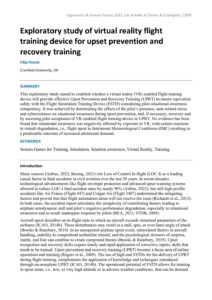
| Document
Insert here |
Author Filip Florek |
| Abstract This exploratory study aimed to establish whether a virtual reality (VR) enabled flight training device will provide effective Upset Prevention and Recovery Training (UPRT) to ensure equivalent safety with the Flight Simulation Training Device (FSTD) considering pilot situational awareness competency. It was achieved by determining the effects of the pilot’s presence, task-related stress and cybersickness on situational awareness during upset prevention, and, if necessary, recovery and by assessing pilot acceptance of VR-enabled flight training device in UPRT. No evidence has been found that situational awareness was negatively affected by exposure to VR, with certain reactions to stimuli degradation, i.e., flight upset in Instrument Meteorological Conditions (IMC) resulting in a predictable outcome of increased attentional demand. |

